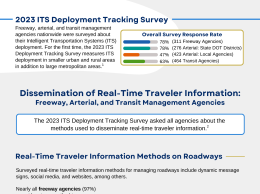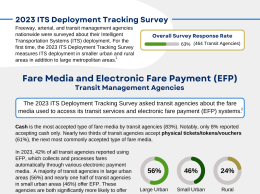2019 Executive Briefing

BRIEFING HIGHLIGHTS:
- Automated Low-speed shuttles (Level 4 SAE Automation) hold up to 15 passengers, have a top speed of 25 miles per hour, and travel about 10 miles per hour.
- Potential benefits of LSS include solving first/last mile challenges, fuel savings, reducing the cost of paratransit, and reducing congestion from drivers looking for parking.
- Issues include public acceptance, the cost of employing an onboard operator, electric vehicle battery performance, and lack of clear business model.
Introduction
Automated vehicles (AV) are expected to transform surface transportation by improving safety while offering convenience and increased productivity to older Americans and people with disabilities. Societal benefits from automated vehicles could include crash savings, travel time reduction, fuel efficiency and parking benefits. Researchers at the University of Texas–Austin estimate the overall benefit at $2,000 per year per AV, potentially approaching nearly $5,000 when comprehensive crash costs are accounted for [1].
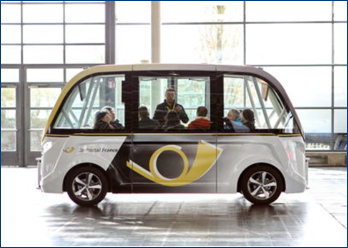
Low speed automated shuttles integrate automation with transit to provide travel between home or office and transit connections. A recent study conducted by the USDOT’s Volpe Center found that there are more than 260 planned, completed, or ongoing low-speed automated shuttle demonstrations and pilots in North America, Europe, Asia, Oceania, and Africa (as of early August 2018) [2].
According to the Volpe Center report, features of Low speed automated shuttles include [2]:
- Fully automated driving (SAE Level 4 automation): Vehicles are intended for use without a driver or operator on board.
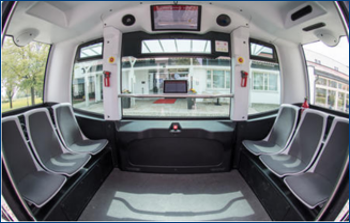
Figure 2: Interior view of a driverless shuttle. Source: Alamy Restricted Operational Design Domain (ODD): Operation is intended for protected and less- complicated environments.
- Low speeds: Service is generally limited to 25 mph (or lower), with cruising speeds around 10-15 mph.
- Shared service: Vehicles are designed to carry the weight of 4-15 passengers, including unrestrained passengers and standees.
- Shared right-of-way: Vehicles share the right-of-way with other road users, either at designated crossing locations or along the right-of-way itself.
Low speed automated shuttles are being used by government agencies, academia and the private sector to introduce the public to automated vehicles.
| Metric | Units | Typical Range |
|---|---|---|
| Passenger Capacity | pax | 10-15 (total) 4-8 (seated) |
| Weights | lbs. (vehicle + pax) | 6,000 - 7,000 |
| Speed | mph | 25-35 (top) 10-12 (crusing) |
| Range | hours / miles | 5-10 (hours) 30-60 (miles) |
Note: Ranges are based on specifications for shuttles such as the EasyMile EZ10, Local Motors Olli, and Navya Arma. Other shuttles may vary in size, weight, speed, and range (Source: Volpe Center, USDOT).
Benefits
Low speed automated shuttles have a number of potential benefits, but in general they have not been widely quantified. Potential benefits include [2]:
- Facilitate understanding and acceptance by introducing the public and internal staff to autonomous vehicles
- Provide new or replace costly first/last mile solutions
- Lower gas usage than privately operated vans and shuttles
- Offer a less expensive method of urban delivery
Table 2 describes three transportation challenges addressed by using low-speed automated shuttles in comparison to non-automated alternatives [2].
| Transportation Challenge | Potential Solution Using Low- Speed Automated Shuttles | Comparison to Traditional Alternatives |
|---|---|---|
| First/last-mile gaps | Feeder service to existing high- capacity transit | May be more cost-effective and more customizable than human-operated feeder service |
| Expense of operating Low-volume transit routes | Smaller (lower-capacity) vehicles without drivers | May be more cost-effective than human-operated 40-foot bus |
| Cost of Paratransit trips and inflexibility for passengers who must book rides in advance | Automated paratransit | May be more responsive to demand and less expensive on a per-ride basis than human-operated paratransit (practicality is still untested) |
Table 3 on the following page shows selected benefits of automated low speed shuttles. To date, benefits of deployed shuttles have focused on customer satisfaction. Users have indicated their overall satisfaction with riding in an autonomous vehicle (albeit with an operator on board) [3].
| Autonomous Shuttle Bus piloted in Minnesota is well-received by the public following successful demonstration of navigating in wintry conditions (2018-01300). |
| Automated first-mile transit shuttles could be three times as effective as human-operated vehicles, according to UC Davis research team (2018-01329). |
| In Detroit, MI, customer satisfaction went from -30 to +67 after autonomous shuttle was introduced and buyer satisfaction was 100 as measured by Net Promoters Score (NPS) (2019-01350). |
Low speed automated shuttles might eventually provide lower-cost public transportation based on the following assumptions:
- reduced labor costs from not employing a driver
- reduced operational costs associated with lower-capacity and fuel efficient vehicles
| “Change is evident and this is going to be a part of the future, so buckle in. I’ve been riding them for awhile and I feel safe. I don’t feel nervous when I’m in them.” - Low-speed automated shuttle user in Detroit [3] |
A University of California-Davis simulation study found that first-mile connectivity systems impacted as little as 12 percent of potential Bay Area Rapid Transit travelers (for the scenario examining a human-operated, shared-pickup shuttle) to as many as 73 percent (for an automated, door-to-door, shared-use shuttle). On the whole, shifting to automated shuttles tripled user share [4].
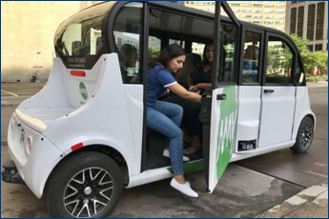
Most early deployments have used an on-board attendant who is able to take control of the vehicle in the event of an emergency or system failure. To fully realize cost savings, some projects hope to remove on-board attendants in the future, but this action is subject to state and local regulation regarding the presence of an on-board operator. In some areas, there is resistance to removing the on-board operator due to safety concerns and opposition to replacing workers [2]. There is uncertainty about whether the price of low-speed automated shuttles will fall due to their current limited market size. The vast majority of vehicles in deployment Are electric vehicles which provide fuel savings, but also raise technological. Issues concerning battery charging, range and performance issues [2]. Currently, no automated shuttle demonstrations in the United States are charging fares to passengers so there is no revenue stream to offset costs.
Costs
The costs of automated low speed shuttle demonstrations have varied depending on the number of shuttles used, vehicle miles travelled, length of lease, and if an operator onboard was required.
| In Arlington, Texas, the cost to lease two autonomous public shuttles to carry passengers from remote parking lots to its stadium venues was $272,000 (2018-00410). |
| In Minneapolis, MN, the cost for a four-month test of autonomous public shuttles was $200,000 (2019-00421). |
| In Denver, CO the cost for a pilot of self-driving low-speed shuttles on public roads was $150,000 (2019-00422). |
Best Practices
The USDOT’s Volpe Center offered the following suggestions to agencies to develop mitigation strategies to overcome barriers to automated low speed shuttle deployment. Considering the following elements upfront may help deployers match capabilities to requirements, plan for contingencies, and ensure that data collection can support decision-making (2018-00836).
- Welcome technical assistance. Deployers contemplating low-speed automated shuttle pilots may benefit from outreach, planning assistance, and professional capacity building.
- Understand the technical capabilities of a desired vehicle. Before committing to a particular vehicle, deployers should work to understand its limitations and talk to other communities or operators who have previously used the particular shuttle model being considered to understand its capabilities and limits.
- Identify operating environment requirements. Communities should identify early applications that provide useful services in low-risk environments to allow for early demonstrations and learning.
- Simplify operating environments. Measures such as adding signage, training, or use of an on-board operator can allow a shuttle to operate in an environment that might otherwise be too complex for safe operation.
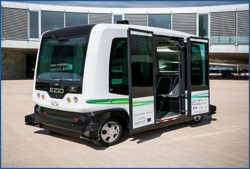
Figure 4: An EZ10 low speed automated shuttle manufactured by EasyMile. Source: EasyMile Conceive a contingency plan. Communities should plan for and map several potential routes before deployment, reducing the potential for delay and cost overruns.
- Identify proper evaluation metrics. Deployers should consider service or learning objectives of the deployment project upfront and use those objectives to identify useful evaluation metrics, ensure that they will be able to obtain the appropriate data, identify their important metrics of interest in advance, and negotiate data sharing agreements upfront.
- Engage Stakeholders. Projects may benefit from involving a broad range of stakeholders early in the planning process, as stakeholder ownership and buy-in may help with some of the financial and acceptance challenges associated with a shuttle project.
- Share Knowledge. Organizations participating in deployment should produce documentation and participate in activities to disseminate information on challenges, lessons learned, and research results both internally and externally.
- Train and develop the needed workforce. Community colleges, nonprofit groups, transit agencies, or other relevant organizations could develop curricula on and provide training programs for automated shuttle operation and maintenance.
- Develop relevant standards. Development of appropriate standards establishing specifications and procedures for performance on low-speed automated shuttles would help address a range of issues, such as supporting functionality, interoperability, comfort, safety, and passenger comfort.
- Do not overlook procurement opportunities. Foreign companies, including EasyMile, 2getthere, and Navya, have created U.S. offices and are looking to begin manufacturing shuttles domestically themselves or through partners, due in part to Buy America requirements. When appropriate, deployment communities shoulder consider using state funds rather than federal funds for procurement.
- Be flexible for funding. Some deployers are pursuing private and local funding to cover costs, as well as considering the use of advertising (either on-board or external) or vehicle sponsorships. Though most deployments are for research purposes and do not currently include passenger fares, some deployers are considering charging fares in future phases.
- Employ public testing. Additional pilots and demonstrations of low-speed automated shuttles may help deployers expose the public to the technology, potentially improving understanding, comfort, and acceptance. Further testing may also build internal staff capacity in understanding the steps involved in piloting a new mobility technology.
Case Study
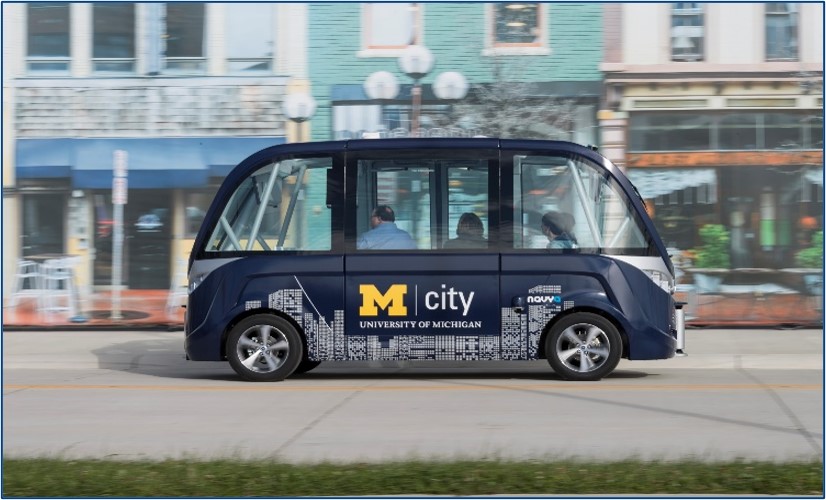
In June 2018, Mcity, a public-private partnership at the University of Michigan, launched a driverless shuttle project in the United States focused on user behavior research. Mcity is studying how passengers and other road users react to and interact with the shuttles as a way to gauge consumer acceptance of the technology. The ultimate goal is long-term deployment of driverless shuttles in the real world.
The two Mcity shuttles are fully-automated, 11-seat, all-electric shuttles manufactured by NAVYA that transport students, faculty, and staff on a one-mile round trip route at the university’s North Campus Research Complex. The shuttles are equipped with on-board cameras, microphones, and Wi-Fi communications to capture data generated during operation. The Mcity shuttles currently operate at a maximum speed of 12 miles per hour.
| Mcity carefully analyzed how to manage possible emergency situations. Safety conductors received extensive training, and Mcity staff developed emergency plans and participated in mock crash scenarios. |
For the Mcity Driverless Shuttle project, safety was the most important factor in route selection, setting operational speed, and programming behaviors at intersections. Safety conductors provide an extra layer of assurance for safe shuttle operation. They ensure that all riders are properly seated and wearing seatbelts and encourage all riders to participate in data collection by completing the user survey [5].
Mcity shared the following lessons learned to help other organizations who may be considering launching driverless shuttle services (2019-00862).
- Set Specific Project Goals. The Mcity Driverless Shuttle was designed to achieve the project goal of understanding passenger and road user behavior while ensuring a safe deployment. This goal shaped project choices regarding route environment, data acquisition, and operational plan.
- Engage Stakeholders Early. Identify key stakeholders early in the process and engage them throughout the project. Their insights are invaluable, and they can flag potential obstacles to progress.
- Explore Legal, Regulatory, and Insurance Questions. To the extent possible, seek to engage federal, state, and local government authorities early, in the planning stages. View government regulators as collaborators as their advice is often invaluable. Connect with institutional and community stakeholders at the outset as preliminary planning and development may require significant lead times for insurance and risk managers, legal counsel, transportation authorities and others.
- Identify Operational Environment Constraints. Careful consideration must be given to a variety of parameters, including weather, roadway and traffic conditions and construction, prior to launch. During operation, constantly monitor these dynamic parameters, as any changes could conflict with defined operating environment.
“Efficient, effective interaction with the targeted rider community and other road users is critical for user adoption and safety” -Mcity Driverless Study [5] Conduct Your Own Testing. Conduct a separate evaluation either by your organization or a third party to evaluate the performance of the driverless shuttle in the operating environment.
- Train Safety Conductors Thoroughly. Create a careful progression of training for on-board safety conductors. Beginning in a closed testing site allowed conductors to build confidence in a safe environment before moving into real traffic conditions.
- Anticipate Challenges. Be prepared for problems that arise when operating in less-than-perfect conditions. You need to be responsive to a dynamic operating environment with robust procedures and communications in place to facilitate smooth operation for conductors, passengers and other road users.
- Develop an Incident Response Plan. Exhaustive emergency preparation is essential when deploying driverless shuttles. All stakeholders must understand their role in an emergency through training and practice.
- Establish Data Needs Early. Define desired data needs early and devise a data collection method that does not interact or interfere with the sensors used by the shuttle for perception and control. This must be done while preserving privacy.
References
- Fagnant, D. and Kockelman, K. “Preparing a nation for autonomous vehicles: opportunities, barriers and policy recommendations,” Transportation Research Part A: Policy and Practice, Vol. 77, July 2017.
- Cregger, J. et al. Low Speed Automated Shuttles: State of the Practice. John A. Volpe National Transportation Systems Center, U.S. Department of Transportation, September 2018.
- Mulder, J. “Now Arriving: 10,000 Rides in a Self-Driving Shuttle,” Medium.com, September 17, 2018. https://medium.com/may-mobility/now-arriving-10-000-rides-in-a-self-driving-shuttle-f8e08b01e5cb
- Rodier, C., et al. Automated Vehicle Scenarios: Simulation of System-Level Travel Effects Using Agent-Based Demand and Supply Models in the San Francisco Bay Area, UC Davis National Center for Sustainable Transportation, September 1, 2018.
- Mcity Driverless Shuttle: A Case Study, University of Michigan Transportation Research Institute, September 2018.

